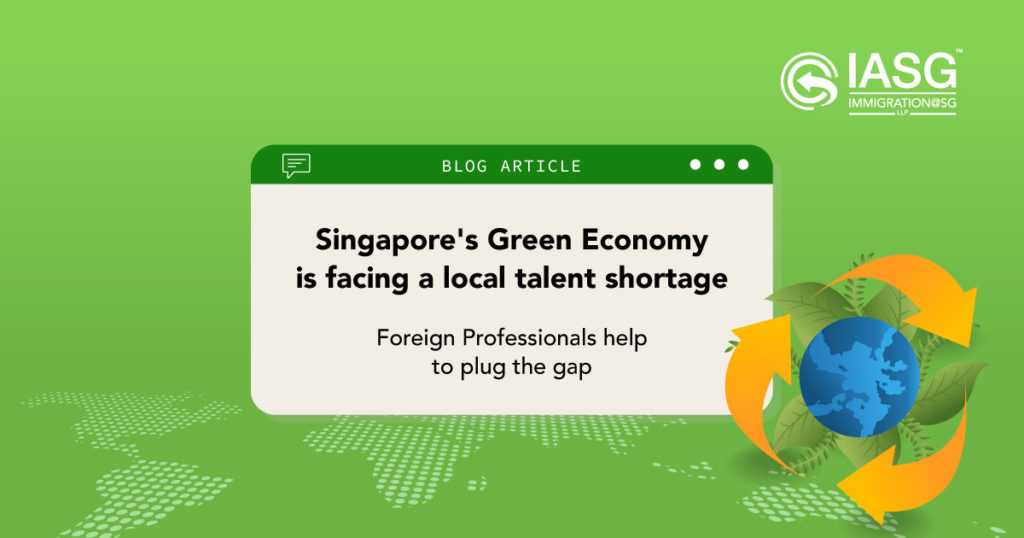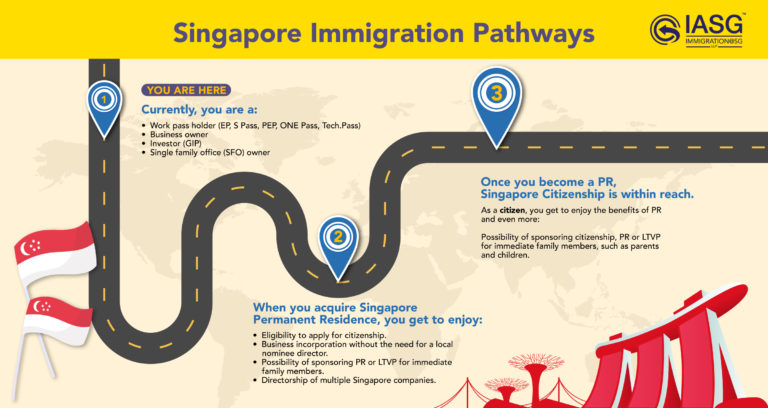On 10 February 2021, Singapore unveiled a grand, ambitious new economic plan: the landmark Singapore Green Plan 2030. As the world progresses towards NetZero, organisations within the relevant industries will be utilising this as a blueprint to drive future policies. Highlighted in the plan was the central idea that sustainability must underpin economic growth, as well as four main strategies to support that goal.
- Decarbonising Singapore’s industries, including the energy sector;
- Driving new areas of growth in the green economy;
- Developing low-carbon solutions and
- Deepening local workforce capabilities.
What do these projects mean for Singapore’s economy and its immigration outlook? For one, existing immigration policies need to be swiftly calibrated to address current talent and skill-set demands more directly. The Green Plan also promises the creation of entirely new industries, roles and opportunities–areas that require external expertise due to the nascency of green sectors in the country. In addition, tech talent in Singapore, along with many other related green industries, is facing a crunch. In other words, Singapore needs foreign professionals to complement the local talent pool by transferring foreign knowledge and helping the local workforce achieve its green goals.
In the following sections, we explore each strategy in greater depth and explain where foreigners can play a role in contributing to economic growth.
Strategy 1: Decarbonisation
Decarbonisation refers to the reduction of carbon dioxide emissions caused by burning fossil fuels. Typically, it is achieved by switching to alternative energy sources such as renewable energy (solar, wind and biomass) and electric vehicles.
The process of decarbonisation is incredibly complex: different strategies have to be formulated for different sectors, new technologies have to be developed and numerous stakeholders have to cooperate to green an entire sector. This necessitates manpower and expertise that Singapore has yet to develop given how new many of these issues are. Foreigners, especially green professionals, thus play an important role: they can provide the guidance, training and support needed for locals to master these skill sets.
A potential point-of-entry for foreigners seeking to sink roots in Singapore is in traditional sectors such as maritime and manufacturing. According to Channel News Asia, 77% of APAC youth, including Singaporeans, want to work green jobs. However, many roles built around decarbonisation-related sectors, such as clean energy, are still in their infancy or do not exist in Singapore yet. Only 15% of youth want to work in “unattractive” legacy industries and traditional sectors–which is where green talent is needed the most to decarbonise.
This gap represents a prime opportunity for foreign professionals. Foreigners with extensive experiences in decarbonisation and legacy industries abroad can help accelerate the decarbonisation of our traditional sectors. More importantly, they can help revive and kickstart the creation of new, exciting green roles and careers in these old industries, attracting even more young local talent. Such contributions to the economy and local talent development make these professionals especially attractive prospects for Permanent Residency and, eventually, even Citizenship.
In September 2023, when the Ministry of Manpower rolls out the final phase of the COMPASS project, abilities to demonstrate such skill and industry relevance will be key for Foreigners looking to secure a role in Singapore.
Strategy 2: New areas of growth
The push for sustainability has created many new industries, roles and sectors. For example, rising carbon taxes and net-zero targets have led to the rise of green finance, as companies seek expert advice to modify their business activities and adopt clean technologies. Other new industries include the carbon credit trade and sustainable investments.
An industry on the rise in Singapore is Sustainable Finance. Sustainable Finance refers to financial activities conducted with environmental, social and governance (ESG) considerations in mind, such as investing in sustainable technological solutions. In Singapore, key activities in the sector include grooming talents in sustainable finance-related R&D, providing sophisticated climate and environmental risk assessments for corporations and developing green solutions for various markets like the insurance and banking sectors. The incorporation of ESG concerns into finance adds new layers of complexity to the financial sector—all of which require professionals with unique skill-sets, such as in social impact, beyond traditional financial training.
Once again, Singapore faces a shortage of experienced talent in Sustainable Finance. Due to the nascency of the sector, many firms lack dedicated staff to track their environmental impact, generate cost-saving green solutions and introduce new technologies. Local universities have started offering courses in Sustainable and Green Finance, but it will take some time for local students to develop skills and experience. Furthermore, most green finance professionals are trained in the West and not enough specialise in Asia’s unique landscape, shrinking the pool of qualified staff even further, in turn discouraging firms from investing in sustainable solutions. Demand for green professionals from abroad, particularly those familiar with Asia, is thus gradually increasing.
Strategy 3: Low-carbon solutions
The alternative energy and low-carbon technology sectors show plenty of potential in attracting new immigrant prospects, and one key source of opportunity lies in Singapore’s bilateral agreements.
Countries such as New Zealand, Australia and the UK are cooperating with Singapore in areas such as energy transition research and sustainable transport. In particular, New Zealand is carrying out initiatives such as information exchanges, knowledge-sharing dialogues and capacity-building workshops to enhance ASEAN’s low-carbon capabilities. Key initiatives also include joint research programmes between the two countries and a “working holiday” scheme allowing New Zealanders to live in Singapore for up to a year, and vice-versa. Cross-country schemes such as these create channels for foreign professionals to move to Singapore, contribute their knowledge and help grow an increasingly-crucial local industry, improving their chances of gaining Singapore Permanent Residency, and for some, even Singapore Citizenship..
Strategy 4: Deepening local workforce capabilities
For Singapore’s green economy to increase and sustain growth long-term, it is imperative that the country develop indigenous capacity to innovate. Many local institutions are launching new courses, such as the National University of Singapore’s (NUS) new Sustainable Urban Development programme, to reskill and prepare students for future green careers.
Despite these efforts, gaps still exist. Grooming students into professionals and leaders takes a long time. There are not enough sufficiently experienced local experts to cover short and medium-term growth, especially given how young many green industries are. Filling up the skilled manpower gap and reskilling existing members of the workforce have thus become key immediate priorities–needs that are most easily resolved by welcoming experienced foreign talent.
Foreign professionals have plenty of avenues through which they can help upskill the local workforce. Many experts take up teaching positions at tertiary institutions or sign up for mentorship programmes to personally develop talents. Others become supervisors at work, guiding and advising their local colleagues as they accumulate new experiences and knowledge. Foreigners owning green businesses create new job opportunities in Singapore, enabling job seekers to gain employment and learn new skills in a new industry. The possibilities for foreigners to deepen local capabilities are endless; the stronger their commitment to helping Singapore, the higher their chances of obtaining Permanent Resident status.
A Key Concern: The Climate Emergency
Any discussion of the Singapore Green Plan necessitates an analysis of the climate emergency, which has hit food and water supplies hard: rivers are drying up, farmers are grappling with unpredictable climate patterns and yields have become increasingly inconsistent. As a country reliant on imports, Singapore has thus had to find solutions to bolster its food and water security.
To get the ball rolling, the Singapore government has invested and put into motion two key projects: the 30 by 30 project and NEWater, to promote food and water independence respectively.
As part of the Singapore Green Plan 2030, the 30 by 30 Project aims to “build up our agri-food industry’s capability and capacity to produce 30% of our nutritional needs locally and sustainably by 2030”. The key engines driving the project are innovation and technology: from the development of indoor LED lighting and aquaculture systems that significantly boost crop yields to the generation of urban farming solutions, a fresh supply of new ideas and creativity is constantly needed to navigate the unique agricultural challenges that come with Singapore’s urbanised landscape and limited space. Because of this, Singapore will also always be in need of experienced human talent, such as climate scientists, agricultural experts, farmers and inventors to rise to the challenge.
The NEWater project, Singapore’s pride and joy, will also have to adapt to rapidly-changing conditions as climate change worsens. Singapore’s water security faces additional obstacles like the impending expiry of the country’s historic 1962 water agreement with Johor (where a large portion of the local water supply is drawn from) and, by corollary, political volatilities. The need to expand our independent water-retention capacities has thus become an even more pressing need—and so does the need for talent in areas like desalination, water policy and reservoir construction.
The existential nature and pressing urgency of the climate emergency, in combination with the nation’s small land size and resource scarcity, means that Singapore will always need new talent; the shortage of qualified local talent means that ICA is likely to approve foreign talent who can complement and develop the local talent pool to fulfil this need. Indeed, this has already become a reality: the Economic Development Board has listed the Natural Resources and Urban Solutions and sustainability sectors as key economic pillars to recruit for, especially in the short to medium-term future.
Attracting Global Talent to Curb Local Talent Shortage
The growth of Singapore’s green economy presents more ripe opportunities for foreigners to settle here, but the process of becoming a Permanent Resident or a Citizen is never straightforward or simple. IASG has assisted many professionals, including those working in green sectors, obtain Singapore PR and Citizenship status, and one key step of the process is to keep abreast of industry trends. This way, each application can be formulated in a way that emphasises each applicant’s unique skill-sets.







